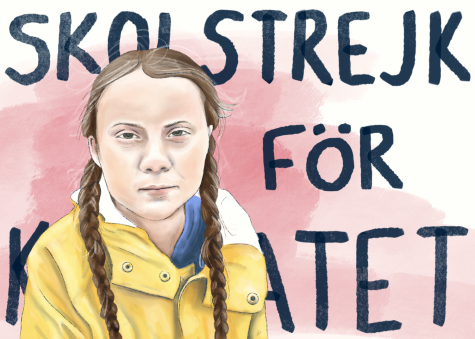Review: ‘I Am Greta’ has amateur filmmaking but powerful content
November 18, 2020
Since then, she has attended numerous summits, conferences and even spoken at the United Nations about the climate crisis. Thunberg has received countless recognitions and awards for her work and was Time Magazine’s Person of the Year in 2019. Although she has been a public figure since 2018, her personal journey has remained mostly private, until now.
Director Nathan Grossman’s latest documentary, “I Am Greta,” follows the climate activist as she travels around the world to convince world leaders to care about the ongoing climate crisis.
The film opens with audio of politicians denying climate change, juxtaposed with visuals of forests burning, cities flooding and storms raging, preparing the viewer for the frustrating scenarios Thunberg will face ahead.
The first half of the film is repetitive and quick and does not allow for much breathing room. Thunberg alternates between riding trains, protesting and giving speeches, seemingly exhausted with the process herself.
“We have to continue to say the same thing over and over again until people get it,” Thunberg said in the documentary.
While it seems Grossman’s pacing of the film was unintentional, it is effective in highlighting Thunberg’s arduous crusade of attempting to make those in power to listen to her.
With shaky camera work, haphazard editing and amateur cinematography, the documentary itself is average at best. But what makes this film poignant and inspirational is Thunberg’s own fortitude and empathy.
Thunberg makes the film worth watching, and her courage alone is what makes the film impactful and awe inspiring, an effect that would have been impossible without her.
From riding in electric cars, taking trains and sailboats, to eating a strictly vegan diet, Thunberg constantly reaffirms her words are not empty and her message will always be backed by actions.
Although footage of Thunberg’s speeches and protests make up the bulk of the film, the most powerful scenes are when she is alone or with her father. In these moments we are able to break through the noise of the media, politicians and crowds and finally see her—not as the leader of the youth climate movement, but as a person.
In these scenes we see her surrounded by stuffed animals and lying with her dog, laughing with her father, baking a cake with her mother and dancing alone in a library. These few moments are short-lived, but are breaths of fresh air in an otherwise emotionally overwhelming film.
Even as she sits alone on a sailboat with waves crashing around her and tears in her eyes because she misses her family, Thunberg’s resilience shines through. We see her nervous, uncomfortable and fearful of the future, but never intimidated or scared.
Oftentimes we place activists on pedestals and treat them as warriors who will save us all. We all too quickly forget that they are humans—not superheroes—and they cannot hold the weight of the world on their own. Thunberg is no different.
Yes, she is brave, intelligent and inspirational, but she is also a 17-year-old girl with Asperger’s, who struggles with selective mutism, anxiety and depression.
While Thunberg consistently reinforces that she is not the focus of the youth climate movement and that the crowds do not come for her but for the issues they are all fighting against, the filmmakers seem to take the opposite stance and instead raise her pedestal even higher.
They make it seem as though Thunberg is the only notable climate activist and do not mention other youth leaders like Anuna De Wever, a Belgian climate activist and friend of Thunberg, who is seen and heard throughout the film but never named.
The lack of focus or even acknowledgement of other climate activists degrades Thunberg’s own ideology of equality and unity during the climate crisis and creates a conflicting narrative throughout the film.
The way Grossman misconstrues Thunberg’s message by showing her as the sole leader and face of the climate crisis movement is inconsistent and confusing. Nevertheless, I couldn’t stop myself from getting goosebumps and feeling tears well in my eyes.
To watch Thunberg go from sitting alone outside parliament to having security guards surround her while she marches with hundreds of others, all while carrying the same “Skolstrejk För Klimatet” sign, was both heartwarming and heart wrenching.
As the documentary bombards us with the message that children will save the world, Thunberg reminds us that they shouldn’t have to.







